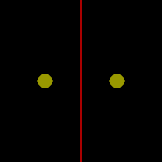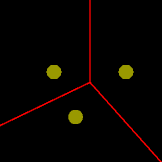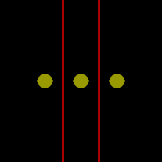 |
|
Packing Pennies in the Plane |
The partition we associate to any distribution of non-overlapping discs in the plane
is its Voronoi partition. We shall show that
for any Voronoi
partition the ratio of the area of a disc to
the area of its cell is at most the ratio of
a disc to its circumscribing regular hexagon.
This will prove Thue's Theorem.
There are a few characteristic properties of Voronoi
cells that we shall require.
The figure also illustrates that
the caps drawn from the triple point
don't overlap (except possibly along their edges), and that
their common vertex angle can be
at most one-third of 4. The Voronoi Partition
Consider any collection of non-overlapping discs of equal
size (possibly just isolated points). We
associate to this collection a partition of the plane into regions called
Voronoi cells.
The Voronoi cell of a disc in the distribution is the set of
points in the plane which are as close or closer to the centre of that disc than to
the centre of any other disc in
the distribution.
This figure is live: the discs are movable.
(1) Since all the discs are of equal
size,
a disc is contained within its
Voronoi cell.

(2) If
(3) For a layout of three discs, the Voronoi cells
will be simplicial cones with a common vertex at one point - the triple point -
which is the common intersection of all three bisectors
between the points - except in the singular case
when the bisectors are
mutually parallel.
This triple point will be equi-distant from each of the three discs.
Draw from the triple point
the pair of tangent line segments to each of the discs,
making a kind of dunce's cap.
The vertex angle of that cap will be the same for each disc,
since this angle depends only on distance of the triple point from the disc.
Because Voronoi cells are convex, the whole of each cap will be contained
in a the Voronoi cell of its disc.


(shown in
pink in the animation) on the line half-way
between them
where the triple point for
a third disc cannot be found.
Moving the third disc (which is `live')
shows how the three vertex angles
remain equal,
and the caps contained in Voronoi cells.
Suppose we fix two of the three discs and ask
how this triple point varies as the third disc moves around.
If the two discs are far enough apart, the triple point can
be anywhere on the line bisecting the given pair.
But as soon as they are close enough together, there will be a
dead space on this line right in between the two
discs where the triple point
can never be found. This dead space will exist as soon
as the centres of discs are closer than
 times their
common diameter. As we decrease the distance between the two discs,
the size of the dead region will expand. This is shown in the animation at left,
where the dead space is highlighted in pink.
times their
common diameter. As we decrease the distance between the two discs,
the size of the dead region will expand. This is shown in the animation at left,
where the dead space is highlighted in pink.